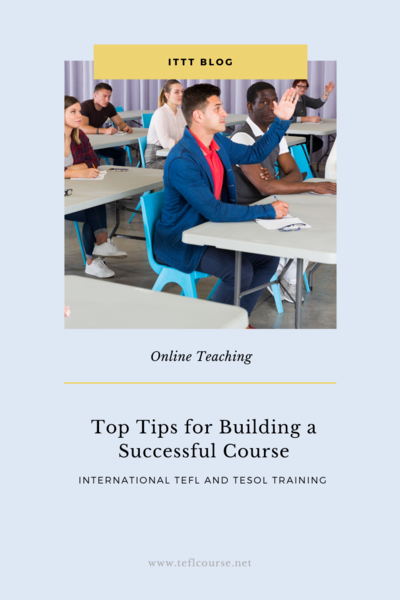Top Tips for Building a Successful Course

To effectively teach English Language Learners the course must be appropriately structured. To structure a course the teacher or school must first know the language ability of the students. This is necessary to enable the teacher to develop materials suitable to the students' level of understanding. It is also valuable to ensure that students in the class are of similar levels of development. If they are not some will be left us and the teacher will have to spend time with individual students which will detract from the time spent with the entire class.
Table of Contents
Do you want to teach English abroad? Take a TEFL course!
This post was written by our TEFL certification graduate Marvin S. Please note that this blog post might not necessarily represent the beliefs or opinions of ITTT.
Placement test
Therefore, at the outset, the teacher will administer a placement test. The placement test should at a minimum contain a written part to determine grammar and vocabulary development. Ideally, the teacher will also interview prospective students to determine their listening and speaking skills, which may be different than their reading and writing skills. This interview can also begin to build rapport between the teacher and the students.

Also Read: Top Strategies for Teaching English Vocabulary
Course Structure
Once the skill level of the students is developed the teacher can begin to prepare for the class. The teacher should probably build a syllabus to help keep on track and ensure that all skills are included. As the course progresses the teacher will administer diagnostic tests to determine what skills, if any need additional work.
Choice of Materials
At this point, the teacher will have to determine what materials will be used in the class. Some options are course books, works books, and self-created material. There are advantages and disadvantages to each option. Course books may be antiquated or not suited to the culture of the students in the class. Workbooks are useful for homework assignments but contain the same potential liabilities as course books. Even if the teacher finds a suitable coursebook, and accompanying workbook, the teacher will find it useful to develop some additional material. In addition to the primary materials, teachers will also want to use videos, stories, maps, whiteboards, magazine pictures, and other supplemental materials. Here teacher creativity is paramount.
Also Read: The 3 Most Important Chinese Policies to Know For Teaching Expats in China
Lesson Plan
With the syllabus written and the materials are chosen the teacher turns to develop lesson plans. Each session should have a lesson plan which, at a minimum should include the name of the teacher, the date and time the class level room number and the expected number of students. The teacher will want to list the teacher's aim, and most importantly, the learner's objectives. There should be space for anticipated problems for both students and teachers and anticipated solutions to those problems. Now the meat of the lesson. The lesson plan should include activities, time, and note whether the interaction is student-student or teacher-student.

Also Read: How long does a TEFL course take?
Teaching Approach
The key to a successful lesson plan, and, in my opinion, a successful ELL class is the use of the ESA pattern of instruction. ESA stands for Engage, Study, Activate. This pattern may be Arrow, (ESA) Boomerang (EASA) or Patchwork, which can be any order so long as it begins with Engage and finishes with Activate.
- Engage. Here is where you get the students' attention and raise interest in what you are attempting to learn in the session. It may include watching a video, reading a story, or a discussion on a topic related to the class objective. Since I believe laughter is an important part of learning, I will probably include some jokes in the Engage phase.
- Study. Here is where the learning begins to take place. It may include written work such as matching, gap fill, word search or other similar activities. During this phase, it is important that not all of the activities be single student activities but should include working in pairs or groups.
- Activate. Now we practice what we have learned. We may do role plays, play games, work together to write a story or other activities that allow us to utilize the skills we have learned.If the teacher follows the outline described here, there will be more successful English speakers in the world.
Do you want to teach English abroad? Take a TEFL course!
Apply now & get certified to teach english abroad!
Speak with an ITTT advisor today to put together your personal plan for teaching English abroad.
Send us an email or call us toll-free at 1-800-490-0531 to speak with an ITTT advisor today.
Related Articles:
- 10+ Activities For Teaching English Winter Camp
- Top 10 Things To Know When Moving Abroad To Teach English
- 7 Activities for Teaching Reported Speech in the ESL Classroom
- What TEFL course is most useful?
- Great Ideas for Teaching Listening Skills in the ESL Classroom
- The Best Countries to Teach ESL When You're 50+




